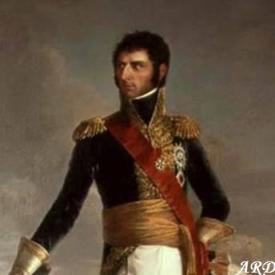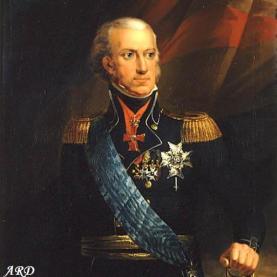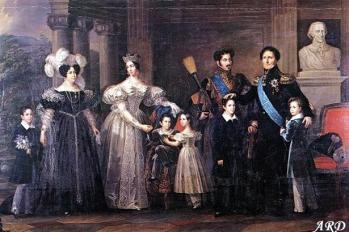The future Swedish Monarch was born on January 26, 1763 in Pau, France. His parents were Jean Henri Bernadotte and Jeanne de Saint-Vincent. To distinguish from an elder brother (also called Jean), the boy was known as Jean Baptiste. He came from a family of lawyers and was expected to continue the tradition; however, Jean Baptiste rebelled and joined the Army.
He started as a private in the Regiment of Royal Marines (so called because they were expected to serve in overseas territories) in 1780. As customary for every new solder, he was meticulously described in special rolls. His description is given as the following: “5 feet 3 inches tall, dark hair, dark eyebrows, small brown eyes, long and pointed nose, small mouth with thin lips, short chin and round face, narrow forehead with two scars, one in the middle and one on the eyebrow”.
After eight years of service, Bernadotte was promoted to a sergeant. After the outbreak of the French Revolution, his considerable military skills were noted and guaranteed him quick promotions. By 1794, he was already a general of a division. Jean Baptiste tried his hand at diplomacy and was briefly appointed French ambassador to Vienna; however, he was forced to resign after his decision to hoist the French tricolour over the embassy caused a diplomatic scandal.
Bernadotte was not among those who supported Napoleon’s coup d’etat Nevertheless, Napoleon was aware of Jean Baptiste’s considerable military expertise and made him one of the Marshals of the French Empire. Honours continued to pour and in 1806, Napoleon created Jean Baptiste the first Sovereign Prince of Ponte Corvo. However, Bernadotte’s relationship with the Emperor was not without friction. During the Battle of Wagram in 1809, he retreated against Napoleon’s explicit orders and was immediately stripped of his command. Bernadotte returned to Paris and was appointed governor of Rome when he was unexpectedly offered the Swedish Throne – as much to the surprise of Bernadotte as everyone else.
This strange development was a result of several unexpected events. The King of Sweden of the time, Charles XIII, was childless and had himself been proclaimed King after the deposition of Gustav IV Adolf. To secure the succession, he had to adopt an heir. Several candidates were considered but the final choice was Prince Charles August of Denmark. His candidacy was supported not only by the King but by three of the four estates – the clergy, burghers and peasants. The fourth estate, the nobility, was considerably more reserved since most of them supported the candidacy of the Prince of Vasa, the underage son of the deposed Gustav IV Adolf.
Charles August was officially named the Crown Prince in July of 1809 and left for Sweden in January of 1810. His arrival was marked by great enthusiasm and honours were lavished upon him; among others, he became the first-even honorary member of the Royal Swedish Academy of Sciences. Unfortunately, this promising beginning came to an abrupt end on 28 May 1810, when the young Prince fell off his horse an died. Although the official autopsy results ruled his death was from a stroke, rumours immediately circulated he had been poised by the Gustavians (supporters of the deposed King). Specifically, they named Count Axel von Fersen (famous for being the confidant and possible lover of Queen Marie Antoinette of France) as the culprit; the Count was lynched in June during the funeral procession of the Charles August.
The death of the Crown Prince once again created a succession crisis in Sweden; courtiers hastily started a search for a new acceptable candidate. It was at this point Baron Karl Otto Morner came to stage. The baron was convinced that in order to secure Sweden’s independent future, it needed to be ruled by a military man. He also believed electing one of Napoleon’s would also ensure the Emperor’s goodwill and so he approached Jean Baptiste Bernadotte – already a well-known figure in Sweden – with an offer of the Swedish Crown. His offer was completely informal and he acted entirely on his own initiative, without having coordinated his policy with anyone at all back in Sweden. Bernadotte was understandably startled at the offer but he didn’t decline it, which gave Morner reasons to believe that should an official approach be made, the Marshal would agree.
Meanwhile, Jean Baptiste told Napoleon of the Baron’s offer; the Emperor thought of the whole affair was quite ridiculous and that Bernadotte had no chances of being elected the Crown Prince. He refused to lend Jean Baptiste his support but refrained from opposing him either.
When news of Morner’s actions became known to the Swedish government, they were met with incredulity and the Baron was immediately placed under arrest. His efforts weren’t in vain though; many courtiers decided to have a serious look at the Marshal of France. The courtiers hoped that the election of one of his Marshals as the King of Sweden will ensure Napoleon’s support, while the Swedish Army, anticipating armed conflicts with Russia, was all for electing a soldier. Besides, Bernadotte was already a popular figure in Sweden because of his chivalrous treatment of Swedish prisoners during the recent war with Denmark.
His candidacy gained more support by day and even the King agreed with it, albeit after much hesitation. And so on 21 August 1810, by 10 votes for and 2 against the Riksdag of the Estates formally elected Jean Baptiste Bernadotte, Prince of Ponte Corvo the new Crown Prince of Sweden. He was also made Generalissimos of the Swedish Armed Forces by the King.
The new Crown Prince still remained a French subject which meant Napoleon had to give his consent. The Emperor was not about to refuse, especially since Bernadotte was effectively a family (he was married to Desiree Clary whose sister, Julie Clary, was married to Napoleon’s brother, Joseph Bonaparte; Desiree herself had been engaged to Napoleon at some point). On 23 September 1810, the Emperor issued formal authorization to the Prince of Ponte Corvo to assume the title and rank of the Swedish Crown Prince.
The authorisation read: “Napoleon, by the grace of God and the Constitution, the French Emperor, King of Italy, Protector of the Confederation of the Rhine, Mediator of the Swiss confederacy, etcetera. Our cousin, the Prince of Ponte Corvo, Marshal of the Empire, by the decision of the Swedish Estates and the King’s will, has been awarded the title of Crown Prince of Sweden with rights to the Throne. But that he, being our subject, could not receive the high rank without our expressive permission to do so. Wanting to give our aforementioned cousin, the Prince of Ponte Corvo, our proof of goodwill, by this announcement we hereby authorise our aforementioned cousin, the Prince of Ponte Corvo, Marshal of the Empire, to receive the title and rank of the Swedish Crown Prince, which he was granted by the Estates of the Kingdom and the King’s will, with all the rights and prerogatives that follow. Signed at our palace on 23 September 1810”. Right after the authorisation was issued, Jean Baptiste renounced his title of Prince of Ponte Corvo and departed for Sweden on September 30 and arrived in Stockholm on November 2.
The King received him three days later, on November 5. The Adoption Act was read before the Estates officially implemented the Parliament’s decision to adopt Jean Baptiste Bernadotte as the Crown Prince of Sweden. In his address, King Charles XIII referred to Bernadotte as “Johan Batiste Julius”. Once the adoption was formalised shortly thereafter, the new Crown Prince was referred to as “son and successor”. He was also assigned new names – Charles (in honour of the King) and John (the modified version of Jean). It was then the newly-created Crown Prince’s turn to make an address. He addressed to the King as “Your Majesty’s most humble servant and loyal subject and dear son Charles Jean”. Then he knelt before the Throne with his hand on the Bible and swore allegiance to the King. The Prince then kissed the King’s hand before the latter stood up from his throne and embraced his newly adopted son.
The solemn ceremony lasted for about an hour and a half. An interesting account of it comes from the memoirs of one Charles Jean-Baptiste Suremain, an exiled French officer in Swedish service. Among other things, he wrote that many were astonished “At how well a former revolutionary soldier fit into a Princely role”.
The new Crown Prince quickly became both the most popular and most powerful man in Sweden. Although Charles XIII was de-jure the King, it was the Crown Prince who did all the ruling. All his efforts were directed to strengthening his adopted homeland which earned him the genuine love and respect of the Swedish people.
One person who was to be deeply disappointed with Bernadotte was Napoleon for the Crown Prince proved to be anything but a puppet of France. When it came to choosing between the interests of his former and current countries, he didn’t hesitate; in 1813, he allied Sweden with Napoleon’s enemies in the hope of securing Norway. His efforts were eventually successful and the Treaty of Kiel recognised the Swedish claim to Norway. The latter then entered into a personal union with Sweden, making Charles XIII also King of Norway as Charles II.
Although effectively ruling in Sweden since 1810, Bernadotte became King of Sweden and Norway on 5 February 1818, upon the death of Charles XIII and II. On the same day, he officially converted from Catholicism to Lutheranism, which had been one of the conditions of his adoption as the Crown Prince.
He was a popular if somewhat strict Monarch and reigned until his death on 26 January 1844(his 81st birthday), and was succeeded by his only son, Oscar I. It is said that during the embalming process they found a tattoo on his hand which read “Death to the Kings!” in French. Oh, the irony!
Bernadotte’s life resembles a fairy tale, in a way; a commoner who started his career as a private, got promoted all the way to a Marshal and then became King. In fact, his story is better than any fairytale because it really did happen. Napoleon’s Empire is now long gone yet the Bernadottes continue to reign in Sweden and in just 5 years time, they’ll be celebrating the 200th anniversary of the House.







No comments:
Post a Comment